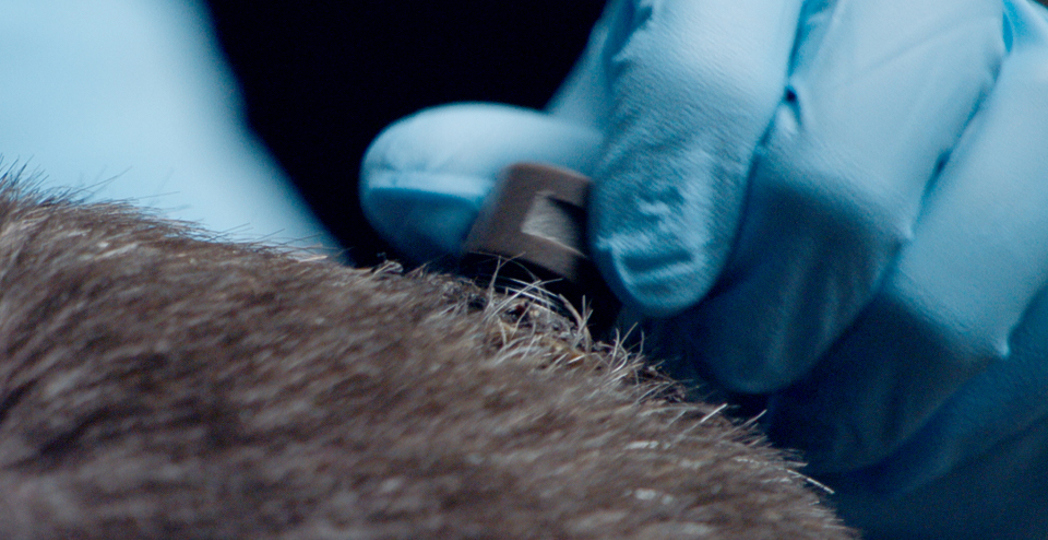I Am Human Documentary Features FES Center, CWRU
by Dillon Stewart | Jan. 27, 2020 | 8:00 PM

As computer brain interfaces allow doctors to augment the human mind, what does it mean to be human, and what does it mean to be a cyborg? A new documentary, I Am Human, premiering in Cleveland Jan. 30 at Playhouse Square’s Hanna Theatre, explores the questions and ethical dilemmas surrounding groundbreaking neurological research.
The documentary, the first feature film as directors from Taryn Southern and Elena Gaby, follows three patients as they undergo high-tech, experimental brain treatments in hopes of regaining body movement, sight and more.
“You’re combining human biology with mechanical or technological pieces,” says Gaby. “By definition, cyborg is the term.”
The film features extensive footage from Case Western Reserve University, the Cleveland Functional Electrical Stimulation Center at the Louis Stokes Cleveland VA Medical Center and University Hospitals Cleveland Medical Center as researchers work with Bill Kovechar, who was paralyzed below the shoulders after a bicycling accident. Kovechar is believed to be the first person with quadriplegia in the world to regain arm and hand movements thanks to the implantation of two temporary pieces of technology.
“We are still so far away from truly understanding exactly how the brain works,” says Gaby. “But at the same time, technology has been advancing so quickly, that it really feels like there's so much hope right now for breakthroughs and progress.”
Ahead of the premiere, which is followed by a panel discussion, we talked to Gaby about making the movie and its Cleveland connection.
Q. You picked three narratives follow. What did their stories represent?
A. When you set out to make a documentary, you don't actually know what the narrative is going to be. We started by researching every possible technology in brain-computer interfaces because the man and machine element was so interesting. We then looked for the institutions that seem to be the most cutting-edge in those particular technologies. Brain stimulation, for example, is one because it's actually been around as one of the longest brain computer interfaces. It's kind of at that exciting point where people are being treated regularly for Parkinson's with deep brain stimulation, but deep brain stimulation is also beginning to be looked at for all kinds of other ailments, like Alzheimer's to anxiety to the severest points of alcoholism and drug addiction and even obesity and other eating disorders, like anorexia.
Who are the patients?
One of the subjects is Bill [Kochevar]. The other one is a woman who was an artist in Canada, and she has Parkinson's. Her Parkinson's has prevented her from being able to make art, and she has all these other symptoms as well. She's the one who undergoes deep brain stimulation. The third person is Stephen, who's also in Canada. He is blind, and he was able to get second sight technology implants.
What made Kochevar an ideal subject?
Bill was a quadriplegic patient who had spinal cord injury after a bicycling accident where he ran into a mail truck. Tragically, he was biking for charity and it was raining, so he had low visibility. He had lived with his parents for a bit, but when they passed away, he ended up at the VA hospital in Cleveland. As a resident there, he heard about a new project that was called BrainGate II. They had done some experiments previously, but Bill was to be the first person to attempt having two [pieces of temporary technology] implanted and also have a functional electro-stimulator in his own arm. He was all for it. So, he had brain surgery, recovered and then had to go through months and months of scientific research to be able to have the arm hooked up and connected. He had to go through training with a virtual arm. He never hesitated even though he knew that this would not provide benefit for him, or for his own personal injury. This was for a future patient. That struck me about him in a major way.
And he viewed himself as part of the team, correct?
For sure. A lot of people don't realize how much the subject matters. The personality of the subject matters in this type of work because you have to be someone who is willing to persevere even when the work is frustrating and difficult and is not going the way you expected.
What ethical questions does this work present?
I think the fundamental one that we talked about in the film is this hypothesis that the brain makes us who we are. And I think a lot of people agree that the brain contains the fundamental elements: our thoughts, our memories, the way we see the world, our perspective. That's really the core of who we are as a person or personality. So if you can read, write, change or intervene in any way in the brain, does that have the potential to change who we are as human beings? And if it does, are we comfortable with that?
In the landscape of this research, how significant is the Cleveland FES Center and CWRU?
Cleveland's at the center. You not only have people like Bolu Ajiboye (assistant professor of biomedical engineering at Cleveland FES Center) and Bob Kirsch (chairman of CWRU’s department of biomedical engineering) doing research with brain computer interfaces and functional electro stimulation, but you also have people like Dustin Tyler (professor of biomedical engineering at CWRU), who are doing work in the sensory feedback space. And one thing people don't realize is how interdisciplinary this work really is between engineers and neuroscientists and computer scientists and all the ways that these people need to come together in order to pull off a technology like this. I think that combination is what really makes Cleveland special.

Dillon Stewart
Dillon Stewart is the editor of Cleveland Magazine. He studied web and magazine writing at Ohio University's E.W. Scripps School of Journalism and got his start as a Cleveland Magazine intern. His mission is to bring the storytelling, voice, beauty and quality of legacy print magazines into the digital age. He's always hungry for a great story about life in Northeast Ohio and beyond.
Trending
-
1
-
2
-
3
-
4
-
5










